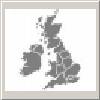49.031 BF989
Timothy Tortrix Aphelia paleana
(Hübner, 1793)
Wingspan 18-22 mm.
A very plain looking moth, usually with a distinct yellowish suffusion around the head and the base of the forewings.
It inhabits waste ground and dampish areas, and feeds on a range of herbaceous plants.
The adults, which are on the wing from June to August, can be flushed from low vegetation during the day but are more active at night.
It is generally distributed throughout, but scarcer in Scotland.
- Larva: (description Ian F. Smith):
Foodplants:Herbaceous plants; Centaurea, Cirsium, Heracleum, Angelica, Daucus, Tussilago, Plantago, Scabiosa, Caltha, Filipendula, Artemisia, Stachys, Trifolium, Rumex, Montia etc. Grasses; Phragmites, Agropyron, Phleum etc.. Occasionally trees; Quercus, Fagus, Rosa.
Early instar in spun leaves in August and September, diapause off plant October to March, late instar in spun leaves April to early June. A pod with frass at the lower end is sown from a single leaf on large leaved plants, such as Centaurea.
Length:Final instar 17 mm or more.
Head:Brown ochre with variable amounts of black. Prothoracic shield:Shiny black, with whitish broad anterior margin and medial line tinted by brown of head beneath.
Thoracic legs:Black.
Body:Black, sometimes with greenish or brownish hue.
Spiracles:Black.
Pinacula:White with black spot at base of seta.
Setae:Translucent pale straw.
Anal plate:Shiny black.
Prolegs:Black with white planta and black crochets.
Similar species A. paleana is a common polyphage, but in moorland habitats A. viburnana is more likely. Check the thoracic leg colour, prothoracic shield and anal plate.

 UKMoths
UKMoths 









